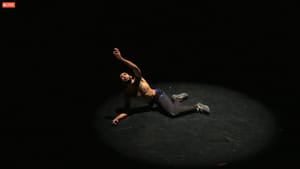Stay in the Loop
BSR publishes on a weekly schedule, with an email newsletter every Wednesday and Thursday morning. There’s no paywall, and subscribing is always free.
An embodied history for our times
The Annenberg Center presents Rennie Harris Puremovement

Celebrated hip-hop choreographer Rennie Harris describes his work as street dance or community dance extending the tradition of African American dance, from slavery and minstrelsy through jazz and bebop to the present. A livestream from the Annenberg Center established the visionary style and approach of his company, Rennie Harris Puremovement (RHPM), as a powerful mode of expression for our times.
The program included five dances that depicted the process of building community out of individuals, the joy of collective expression, and the pain of loss when violence, prejudice, and oppression enter the community.
Athleticism and aesthetic
The first piece, Continuum, introduced the five dancers’ athleticism as well as their expression of RHPM’s aesthetic. Joshua Culbreath, Phillip Cuttino Jr., Lucas Mikan, Emily Pietruszka, and Kai Rapelyea each took their turn inside a spotlit circle, dancing to DJ Lee’s upbeat mix full of trumpet riffs. This exuberant work included physical feats that showcased the explosive energy as well as the diversity of hip-hop dance. The performers’ variety of strengths—including jumps, spins, flips, power moves, duck walks, and defiance of gravity—also suggested hip-hop’s connections with other forms of movement, from tap and stepping to gymnastics and LGBT ballroom.
The dancers’ attire reflected unity in diversity as each wore their own version of a top, pants, and sneakers in all black. In Continuum and throughout the program, changes in lighting mirrored changes in sound and movement, creating a particularly striking trompe l’oeil effect as this dance drew to a close. As the lights slowly went down on a lone dancer, the music faded and Pietruszka appeared to be not on a stage but inside a screen.
Movement and narrative
Pietruszka returned with Culbreath and Cuttino for The Word, which demonstrated Harris’s strengths in appealing to the eye through changes in tempo, formation, level, synchronicity, and use of space. Culbreath and Cuttino first moved slowly, alternately creating the illusion of gliding across the stage and walking in slow motion, before catching the beat of music by Osunlade. Pietruszka joined them for a combination that included a repeated gesture of the right leg kicking out and swinging back. This created another illusion, a paradox of stillness in movement as the dancers rocked and hopped energetically but never moved very far.
Next, Cuttino performed the solo The Big What If, which he choreographed. Before beginning to dance, Cuttino mimed receiving gunshot wounds and calling for help. The music changed, and Cuttino leapt into a series of joyful hands-free somersaults. The Big What If ended with his character waking suddenly to the sound of a siren. A resonant piece as the city and the country grapple with establishing a society in which Black lives matter, it took on special relevance during the Q&A, when Cuttino revealed that he has been shot as a bystander. He described police drawing guns while he lay wounded.
Fittingly, the program concluded with A Day in the Life and Black Promises, which tell the story of brothers (Cuttino and Rapelyea) caught up in a street altercation with the police and conclude with anguish at the systemic brutality against Black men.
A Day in the Life feels timely, but Harris created the piece in 1995. While I had seen both pieces before, when RHPM performed them in Koresh Dance Company’s 2019 Come Together Dance Festival in fall 2019, the two dances remain as moving as ever. The second piece, a survivor’s solo choreographed and performed by Rapelyea and directed by Harris, drew on lighting, sound, and the dancer’s hypermobile joints to portray grief and suffering. Beyoncé’s “Sandcastles” played as Rapelyea’s body was cast in half-shadows, his muscles and sinews contorting into a bodily expression of psychic and emotional trauma. It was a beautifully devastating end to the performance.
A dance journey
In between the dances, Harris appeared live via Zoom to comment on his work and artistic philosophy. In his final appearance, he noted that the storytelling in rap music inspired him to tell stories in dance. After a brief pause, during which the audience was invited to submit questions in the livestream’s chat, the dancers took the stage for a live Q&A moderated by Deborah A. Thomas, the R. Jean Brownlee Professor of Anthropology and Director of the Center for Experimental Ethnography at the University of Pennsylvania, who formerly danced with Urban Bush Women a Brooklyn-based dance company. Harris joined the Q&A on Zoom.
The fascinating discussion addressed the difficulties of performing after the pandemic shutdown, the importance of community among RHPM dancers, and the art form of hip-hop concert dance. Harris described creating a program that takes viewers on a journey through preconceptions about street dance—reflected in the nonnarrative, largely improvisational opening piece—to the final pieces’ vision of storytelling dance. In combining the rich traditions of African American dance with the ever-adapting future of hip hop, this performance from RHPM drew on aspects of celebration, expression, and oppression in street dance to offer stories in movement and embodied history for the 21st century.
Image description: A photo of dancer Kai Rapelyea, a Black man wearing black pants and gray sneakers. Seen from above, he lies on a dark, empty stage and turns his face and one arm upward as if in anguish.
What, When, Where
The Annenberg Center presents Rennie Harris Puremovement via livestream on April 1, 2021. A recording is available on demand to ticket holders through April 3. Annenbergcenter.org.
Sign up for our newsletter
All of the week's new articles, all in one place. Sign up for the free weekly BSR newsletters, and don't miss a conversation.

 Melissa Strong
Melissa Strong